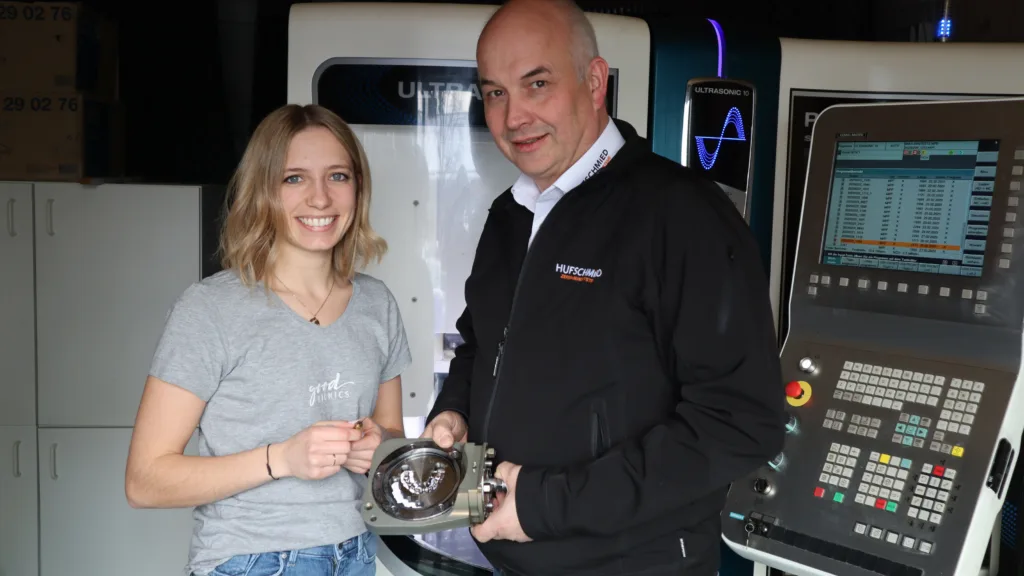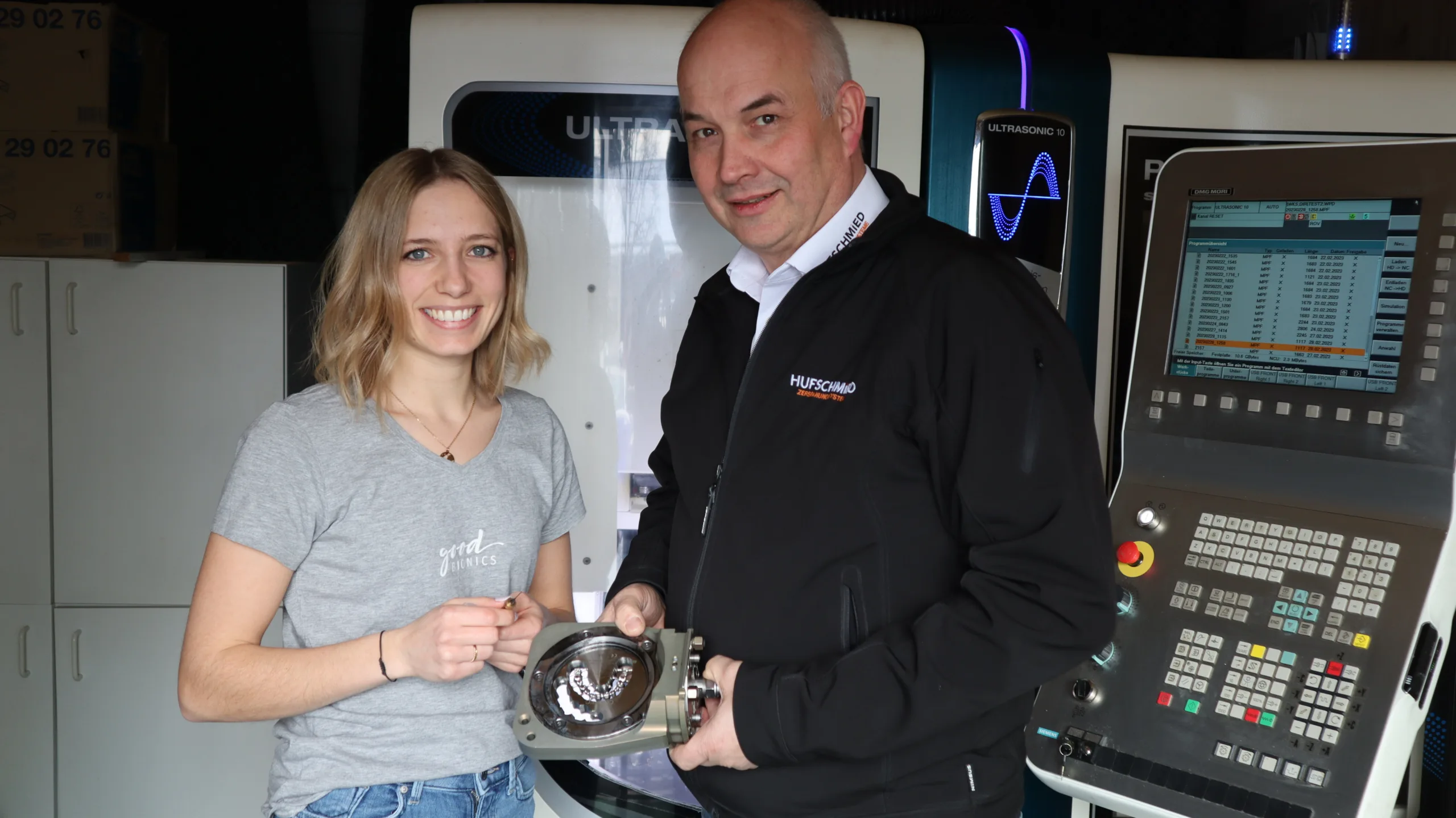
The goodBIONICS biotechnology GmbH researches new implants and also strives for innovative methods in her own dental technology laboratory. In collaboration with the Hufschmied Zerspanungssysteme GmbH proved that it is worthwhile to optimize machining processes.
The machining of zirconium dioxide, cobalt chromium, titanium, PMMA and other industry-typical materials in dental laboratories is usually characterized by complete solutions. System providers usually supply versatile universal tools with the machines. However, common practice does not mean that it is not possible to optimize machining processes in the dental industry. A scientific comparison test of dental technology tools for zirconium dioxide processing at the Augsburg University of Applied Sciences in 2020 showed that the selection of milling tools has a significant influence on the quality of the results and the efficiency of the processing. The tool specially optimized for this material Hufschmied Zerspanungssysteme GmbH emerged as the winner of the benchmarks. The fact that the company, which specializes in material-specific tools, found goodBIONICS' open ears with its products and consulting approach is no coincidence. “I admit we have some interest in mechanical engineering. For example, we have extensively modified our old KaVo Everest milling machine and equipped it with new drives,” reveals Benjamin Schick, Managing Director of goodBIONICS Biotechnologie GmbH. “Since we bought a DMG ultrasonic milling center, we have really wanted to exploit the technical possibilities.”
After the first contact via the tool manufacturer's technical sales department, Michael Mödinger, one of the application engineers and CAM programmers, visited Hufschmied, goodBIONICS. As usual, the dental laboratory in Mauerstetten near Kaufbeuren has so far worked a lot with the standard templates in hyperDENT, but: “An optimal milling process requires a tool that fits the material, as well as tool paths and cutting parameters that make optimal use of the machine's capabilities. The best way to do this is in the CAM program,” says Mödinger. “Michael Mödinger visited us repeatedly over the course of about a quarter of a year and helped us optimize the parameters,” reports Melanie Keller, the dental technician who has developed into a CAD/CAM specialist at goodBIONICS. “We have also carried out service life tests and therefore know exactly how long we will last Hufschmied-Be able to use tools in each case.”
The right tool for every material

Until now, one problem when processing plastic was the smearing of the tools. With the Hufschmied- Milling tool 110FPRDTA avoids this. The special single-edged geometry ensures that thermoplastics do not heat up too much during processing. The processing time of, for example, dental splints to prevent nighttime teeth grinding could be reduced by around 30 percent with changed cutting parameters and the results were more accurate. The specifications for the speed as well as for feed and infeed have been changed in the hyperDENT templates.
When processing cobalt chromium, which the dental laboratory uses to produce bridges, crown frameworks, molar crowns, bars, abutments and telescopic denture parts, tool breakages used to occur frequently. With the HC634DTA, a four-edged tool from the dental line Hufschmied, dimensional accuracy and surface quality could be improved. Melanie Keller states: “We save around ten percent of processing time and have a much higher level of process reliability.” Michael Mödinger remembers: “What was interesting about this optimization was that we focused less on measured values, as we would in other industries. but that we used processing samples to approximate the cutting values that led to the best optical results.”
Visual appearance is also important when producing bridges and crowns from zirconium dioxide. The material is challenging to machine and standard tools wear out quickly, while thin structures break easily. This was special in the benchmark test at Augsburg University Hufschmied-Tool successfully milled even 0,1 mm thin zirconium crenellations in 54,17 percent of cases, where all other tools were only able to achieve very few successes or no good parts at all. The long service life and process reliability with thin structures are also particularly valued by goodBIONICS in the specially coated tools equipped with a particularly smooth-running three-edge geometry.
Process for new material
The ability of HufschmiedUsing the tool for zirconium dioxide to precisely create even finely tapered shapes also comes into play with another material. “Very thin restorations, long-term temporaries and veneers no thicker than a contact lens – for these tasks we use the comparatively new material Vita Enamic, for which we developed optimal processes right from the start,” says Benjamin Schick. Vita Enamic is the first dental hybrid ceramic with a dual network structure. In this material, the dominant ceramic network is reinforced by a polymer network, with both networks completely penetrating each other. “Composite materials regularly pose special challenges for machining due to the combination of very abrasive components with heat-sensitive plastics. It is good that we are at Hufschmied “We have specialized in exactly these challenges for many years,” says Mödinger, who has also advised companies in the automotive and aerospace industries on the processing of composite materials in the past.
Outlook and conclusion

goodBIONICS is currently developing an implant process with patient-specific one-piece ceramic implants together with the University Hospital Hamburg-Eppendorf and a partner from the coatings sector in an SME innovative project funded by the Federal Ministry of Education and Research. “Highly individual implants will have to be manufactured individually. We are looking forward to working together Hufschmied to tackle the development of an optimized machining process for the new implants,” says Benjamin Schick and concludes with concerns: “It may have given the impression that only our special equipment with an industrial milling center suggests optimizing the processes with special tools. However, we still use our dental machines - for example for dry zirconium cutting - and here too it was worth adjusting the parameters. We were also able to save ten percent of processing time on the table machines, improve quality and benefit from longer downtimes.”

